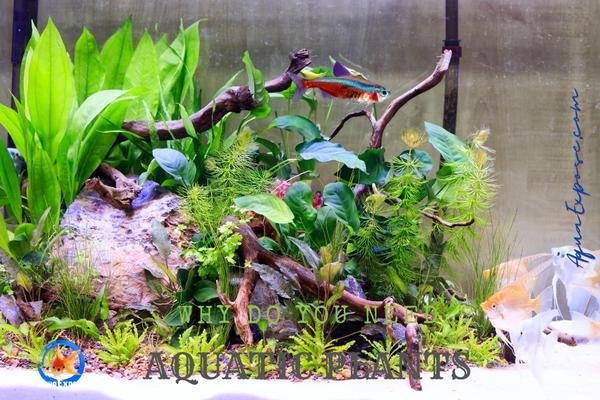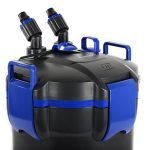Types of Aquatic Plants & Why Do You Need Them? –[Best Low-Budget Aquatic Plant Ideas for Beginners]

Aquarium plants can provide several miracles to an aquarium. These plants have the ability to add aesthetic value, increase biodiversity, and improve the environment in which the aquarium resides. There are several Types of Aquatic Plants around us. Aquatic plants come in different categories. We’ll discuss a variety of aquatic plant types in this article.
Aquarium plants add beauty and interest to an aquarium while providing essential environmental benefits. They help keep oxygen and carbon dioxide levels balanced and provide places for fish to hide and play. They also help reduce algae growth, clarify the water, provide important nutrients to the water, and act as a natural filter to help remove toxins.
Why Do You Need Aquatic Plants for Your Aquarium?
Aquatic plants have adapted to live in water, be it fresh or saltwater. These plants provide a range of benefits, from creating oxygen to filtering water and providing food and shelter for other aquatic species. There are a wide variety of aquatic plants, ranging from algae and submerged plants to floating plants and emergent vegetation. These plants are important for a healthy ecosystem and are vital components of aquatic habitats.
In addition, here are five reasons you might want to add an aquarium plant to your collection.
- Provide shelter and hiding places for fish and invertebrates, fostering better health and reducing stress levels.
- Filtering out toxins and unwanted nutrients from the water provide a healthier environment for all the creatures in your tank.
- It oxygenates the water, trying to create an environment similar to a natural aquatic ecosystem.
- You are enhancing the beauty of your aquarium with vivid colors and attractive foliage.
- Adding an extra biofiltration layer can reduce the need for frequent water changes.
Aquarium plants provide a natural habitat for fish
By adding natural foliage, your fish can use the plants as cover, allowing them to feel more secure and giving them many places to explore. Additionally, the welcoming environment facilitates natural behaviors, such as breeding and nesting.
Adding Aquarium plants are also a great way to keep the water within your aquarium clean. Plants use the waste in the water as a food source and help maintain the balance of nutrients and oxygen levels. The leaves and roots also act as a natural filter, taking in toxins and organic pollutants and trapping them before they enter the water.
Aquarium plants provide color and visual interest-
Aquarium plants add both color and visual appeal to your aquarium. Adding various aquarium plants can create a unique aquarium that looks amazing and provides a healthier environment for your fish. Plus, having a lush background of aquarium plants allows you to feature your fish rather than having a lifeless tank.
Finally, aquarium plants significantly benefit the environment by providing essential nutrients and oxygen to the water and helping maintain a balanced ecosystem. Aquarium plants are a great addition to any home aquarium and offer many advantages, including improved health, better aesthetic appeal, and increased biological activity.
Aquarium plants remove waste and debris from the water-
The roots of aquarium plants take in waste and debris, such as residues, uneaten food, and other organic matter. This organic material is then broken down by beneficial bacteria, thus helping to keep the aquarium clean and free of pollutants. The plants also help reduce nitrate and phosphate levels, which can lead to algae overgrowth in a tank.
Aquarium plants also provide an oxygen boost.
Aquarium plants absorb carbon dioxide vital and release oxygen back into the water. This is important for maintaining a healthy environment for fish and other aquatic creatures.
Aquarium plants add oxygen to the water-
Besides adding oxygen through photosynthesis, some aquarium plants (such as water lettuce and duckweed) also increase the oxygen levels in an aquarium by releasing harmless bubbles of oxygen into the water. This oxygen boost is especially beneficial during the night when photosynthesis is impossible.
Know about The Different Types of Aquatic Plants?

Aquatic Plant Categories:
Aquarium plants can be categorized in several ways, but one of the most popular is aquatic plant types. There are fish tank plants, substrate plant types, driftwood aquarium plants, and orchids, to name a few.
Once you have purchased your aquarium starter kit and chosen aquatic plants that best fit your aquarium’s type (fish tank vs. planted aquarium), it’s time to get planting!
Various aquatic plants are available today, so deciding which type to buy for your specific setup takes time and effort. To help make this decision more accessible, we’ve compiled an aquascape plant guide with a few different categories for you to peruse!
Foreground Plants
Having plants in your aquarium can be a relatively inexpensive proposition. Some foreground plants that work well planted can be had for a fraction of the price of those that thrive in an aquatic environment.
Choose plants accordingly by checking out our featured plant list, which includes species appropriate for planted aquariums!
Midground Plants
Plants add character and life without breaking the bank when starting an aquarium. There are a variety of midground plants that will work well in planted aquariums – seagrasses, java ferns, and beard grasses, for example. Make sure to water your plants regularly and keep an eye on their condition, so they stay healthy and happy!
Background Plants
When it comes to plants, it’s essential to take some time to get them the right water and substrate. Additionally, there are planting schedules that need to be followed as well as fertilizing guidelines.
More categories:
1. Water Column Plants – These are tall, narrow plants that grow in the water column and are ideal for providing shade and shelter for fish.
2. Mosses & Liverworts – These plants are great for softening hardscapes, providing shade, and preventing algae growth.
3. Floating Plants – Easy to care for and low-maintenance, floating plants cover shy fish and consume nutrients from the water that would otherwise fuel algae growth.
4. Bulb Plants – Bulb plants like Anubias and Aponogetons are known for their slow growth and low maintenance levels and are ideal for small aquascapes.
5. Other Plants – These plants include Potamogeton, hornwort, and Actinidia, all valuable additions to the underwater landscape. They provide structure and oxygenation.
The best low-budget Aquarium Plants for Beginners
It’s easy to get carried away with aquariums and aquarium plants and end up spending a lot of money on fish and plants that need to live up to your expectations. That’s where the best low-cost aquarium plants for beginner aquarists come in. Many plants are suitable for fish tanks of all sizes, and many of them are low-cost options.
Related Article You May Like: How to Create a Stunning Planted Aquarium on a Budget?
Be sure to check the water quality regularly, and pay attention to the fish – if they seem to be struggling or the water quality is off, change the water immediately. In addition to plants, you can also add live aquatic invertebrates such as java fern and Amazon swordfish grass. These plants help to clean the water and provide a hiding place for fish. Keep an eye out for beneficial bacteria and fungi that can help improve tank conditions. Once you have a planted aquarium setup that’s comfortable for your fish and tank conditions, it’s time to start stocking it with fish!
Here, we described some low-budgeted aquatic plants below

Image Credit: Mainam Brand- Amazon
Mosses:
Mosses aren’t technically a “plant,” but they are famous for aquascaping. They come in various shapes, colors, and textures, making them an excellent option for those new to aquascaping.
Java moss
Java moss is a great beginner plant because it doesn’t need much water or light. This makes it perfect for beginners, as well as those who live in low-light conditions.
It grows quickly and can be planted in a matter of minutes. You’ll soon have an impressive tank full of java moss plants!
Anubias Nana
Anubias plants are low-maintenance, slow-growing aquarium plants with thick leathery leaves and a creeping rhizome root system.
Looking for an affordable plant that can be easily maintained in an aquarium? Anubias nana might be the perfect option! This low-budget plant is tolerant of a wide range of water conditions and grows fast, requiring little sunlight or nutrients. Mixed with other plants, it can create an eye-catching aquarium display.
Anubias barteri
Anubias barteri is a hardy aquarium plant that can tolerate low light and water conditions. It’s an excellent choice for beginner aquarists who want affordable plants with minimal maintenance requirements.
Java Fern
These are also low-maintenance aquarium plant that provides a carpeting effect with their short leaves.
Java Fern is a plant that will look great in any aquarium. Its leaves are bright green and resemble those of a tree, making it an attractive addition to any tank. Java Fern can proliferate, so get started today!
Amazon Sword
Amazon sword is an excellent plant for beginner aquariums. It needs very little water or light to grow, and its leaves are dark green with a sword-like shape that will stand out in an aquarium. Additionally, java ferns make a great budget-friendly option for planted aquariums – they come in various shapes and colors and are relatively easy to take care of.
Cryptocoryne wendtii
These plants are known for their thick rosettes of bright green foliage, making them perfect for creating a dense backdrop in an aquarium.
Cryptocoryne wendtii is a great low-budget aquarium plant for beginner aquarists. This easy-to-care-for plant thrives in low-light conditions and can be grown indoors or out. The narrow leaves of these aquatic plants make them perfect for planted aquariums as they produce dense growth that doesn’t require frequent water changes like other plants might.
Micro Sword
Micro sword is an aquatic plant that can be used in planted aquariums. It has narrow leaves and produces dense growth, making it a great option for beginner aquarists who want an easy-to-manage plant without spending much money.
Green Myrio
Green myrio is a hardy aquarium plant that grows quickly and produces dense growth. It’s an excellent choice for beginner aquarists who want an affordable plant with minimal maintenance requirements.
Ludwigia
Ludwigia is an aquatic plant that can be used in planted aquariums. It has slender, aqua-blue leaves and produces dense growth. This easy-to-care-for plant thrives in low-light conditions and requires little water or fertilizer to grow.
Rotala Indica
Rotala Indica is an aquatic plant that can be used in planted aquariums. It has dark green leaves and produces dense growth. This easy-to-care-for plant thrives in low light conditions, making it a great option for beginner aquarists who want an affordable plant with minimal maintenance requirements.
Vallisneria:
Vallisneria is a fast-growing aquarium plant with hollow, ribbon-like leaves that can quickly create a lush environment in any aquarium.
Aquarium Plant Pack
If you’re looking for an aquarium plant pack with various aquatic plants, look no further than the Amazon Aquarium Plant Pack. This 8-pack includes plants like Micro Sword, Green Myrio, Ludwigia, Rotala Indica, and more. Each plant in this pack is low-maintenance and easy to care for.
Conclusion
Aquarium plants are a fantastic addition to any aquarium. They provide various benefits to both fish and plant owners, so why not add some to your aquarium today? In this article, we’ve outlined why aquarium plants are such a great option and provided some info on the variety of aquatic plants for your tank. Ready to add some underwater magic to your tank? Let’s get started!

